Swarm optimization approach for light source detection by multi - Robot system
Exploration and searching in unknown or hazardous environments using multi-robot systems (MRS) is
among the principal topics in robotics. There have been numerous works on searching and detection of odor, fire
or pollution sources. In this paper, a modified Particle Swarm Optimization Algorithm (PSO) was presented for
MRS on detecting light sources, namely APSO. In the proposed algorithm, an integration of conventional PSO
and Artificial Potential Field (APF) is employed to use swarm intelligence for space exploration and light source
detection. The formulas for APSO velocities are based on those of PSO and APF. Furthermore, each particle is
surrounded by an APF that forms repulsive force to prevent collision while the swarm is in operation. The
simulation results of APSO in Matlab by various scenarios confirmed the reliability and efficiency of the
proposed algorithm.
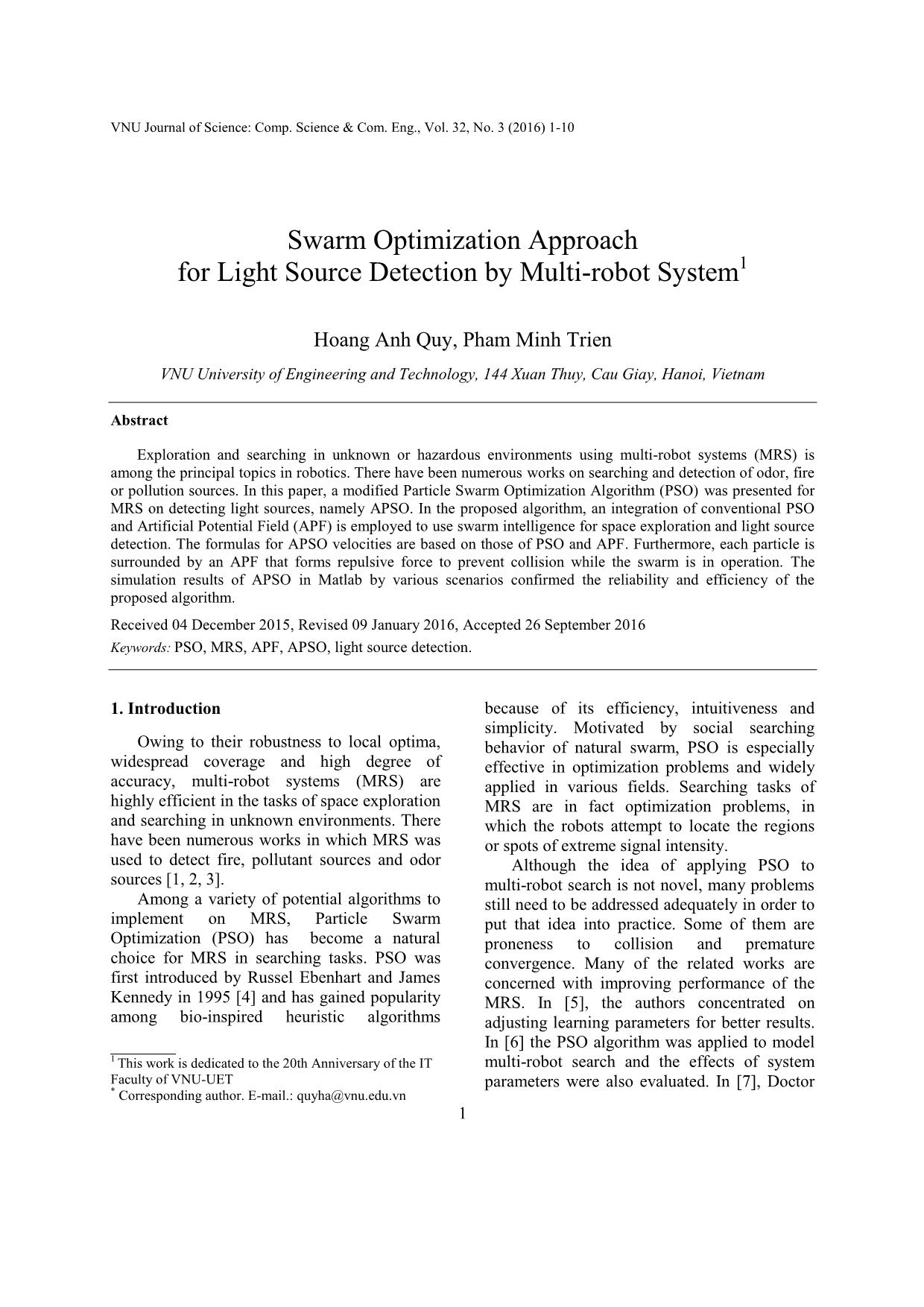
Trang 1
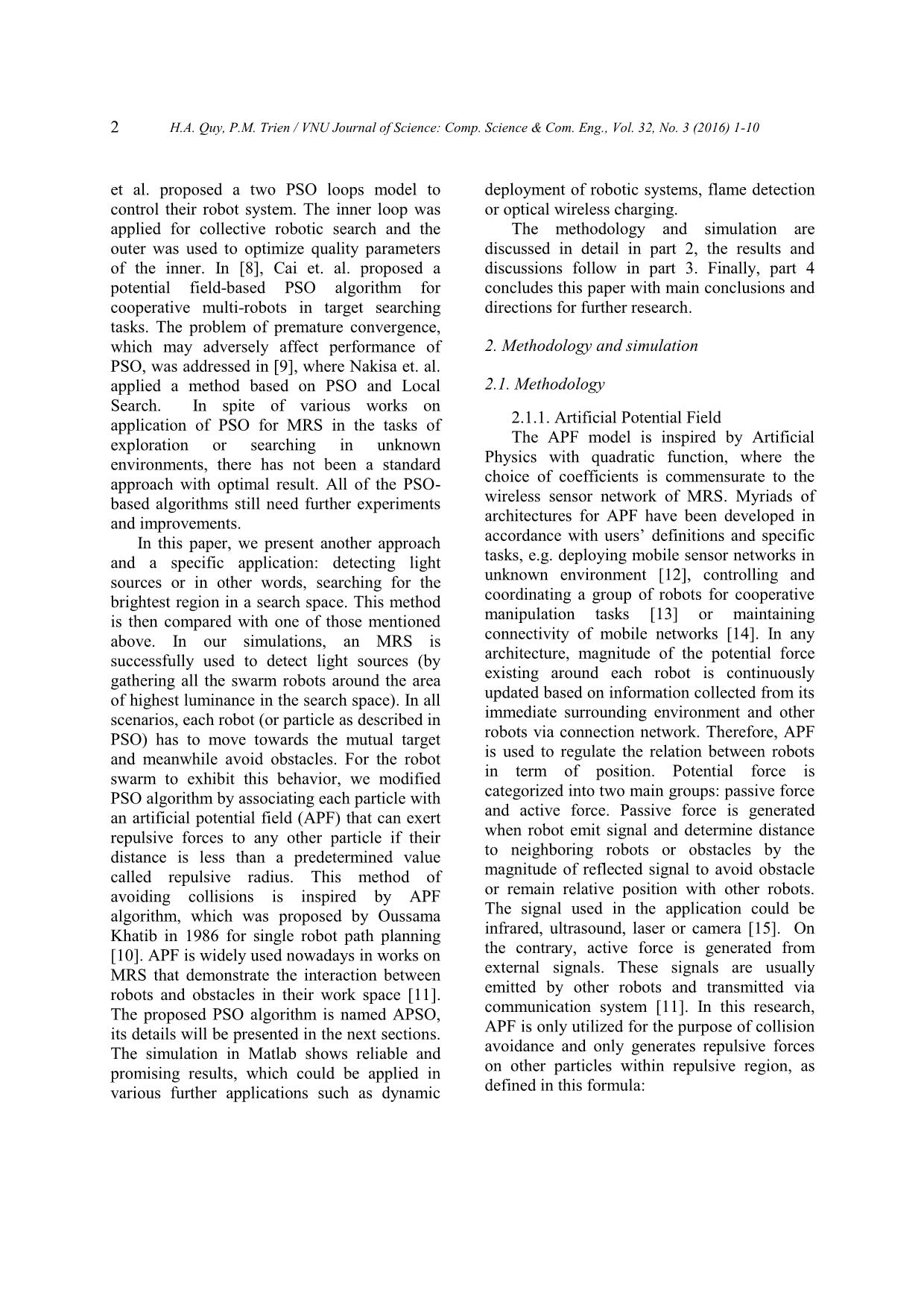
Trang 2
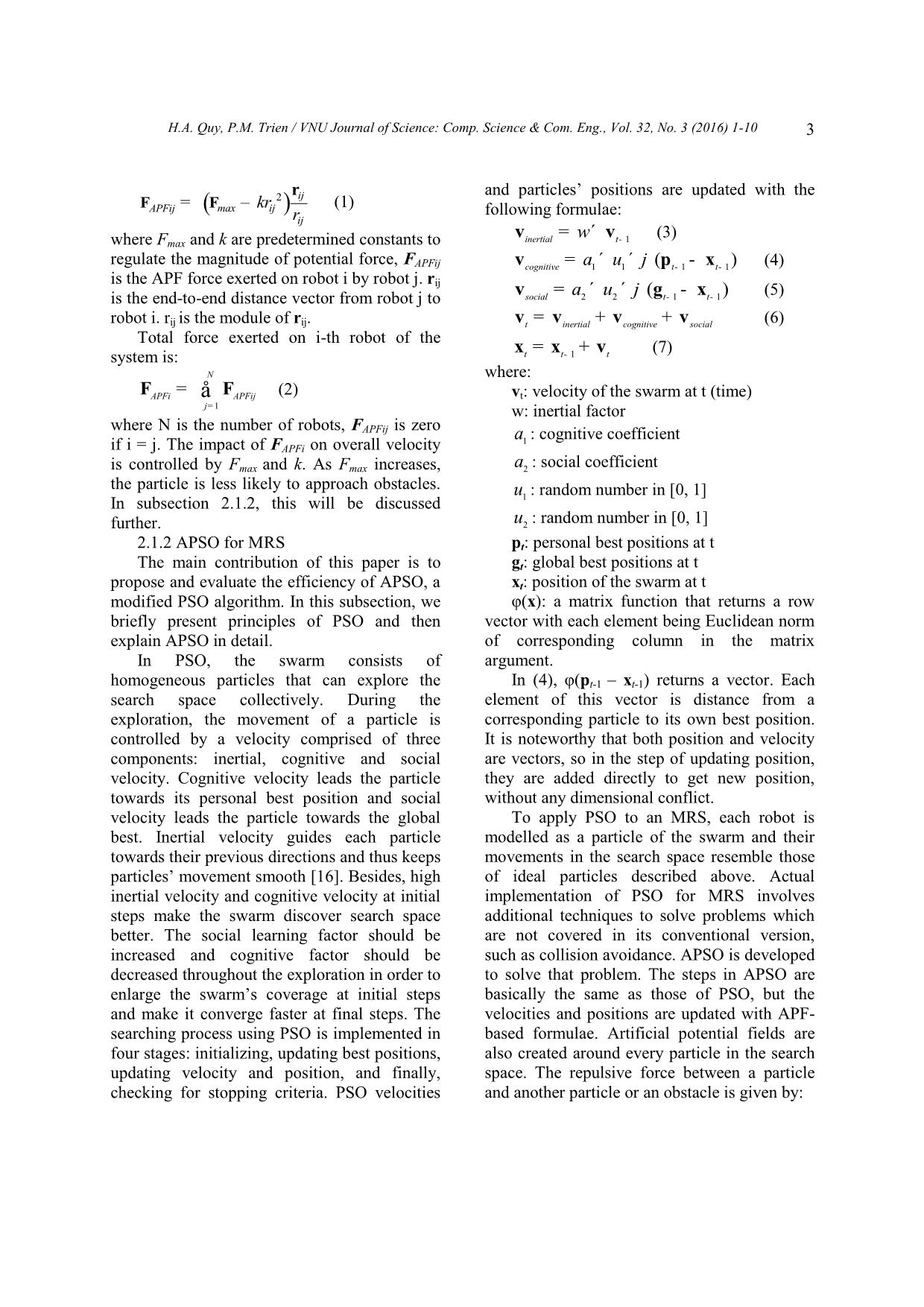
Trang 3
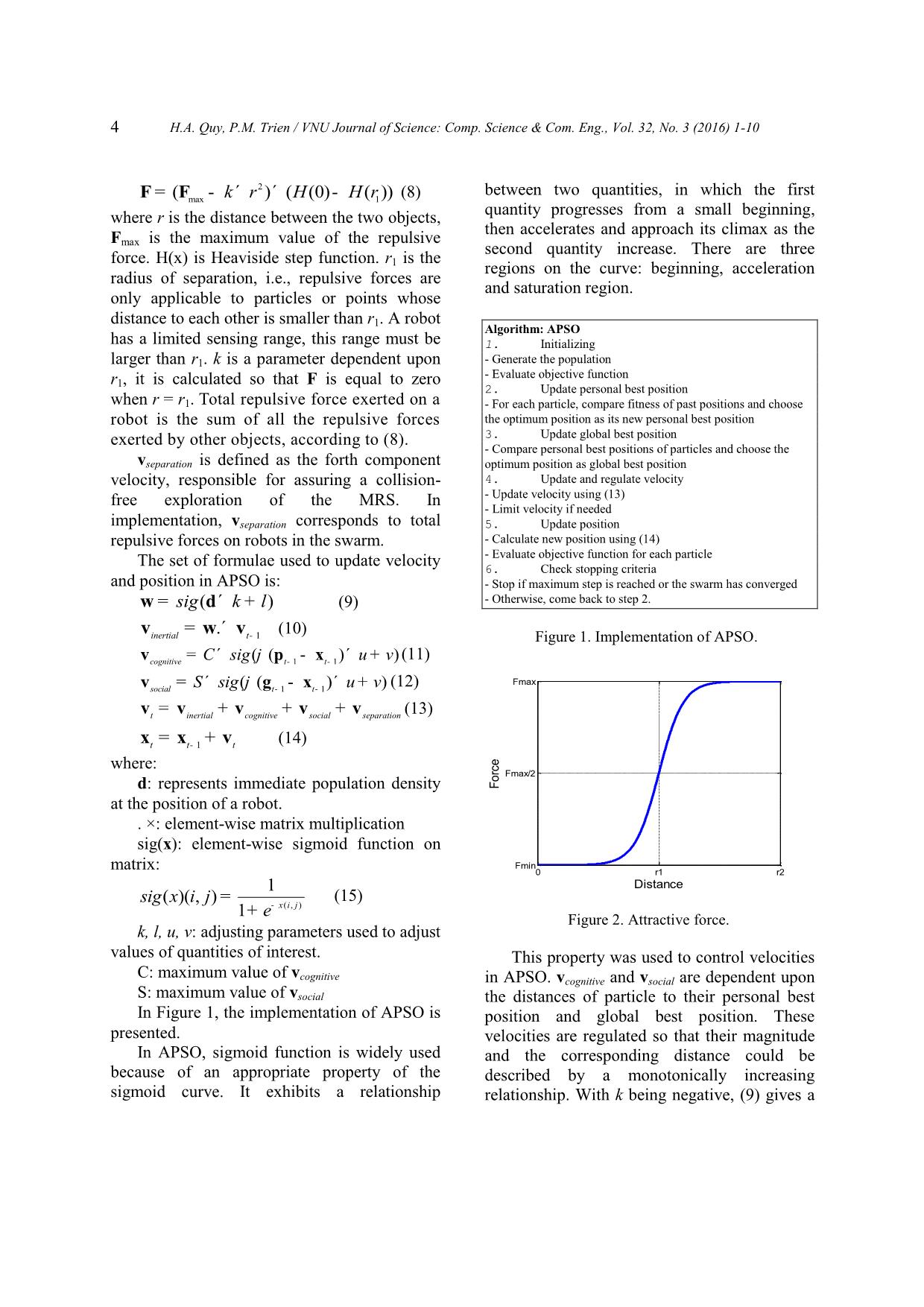
Trang 4
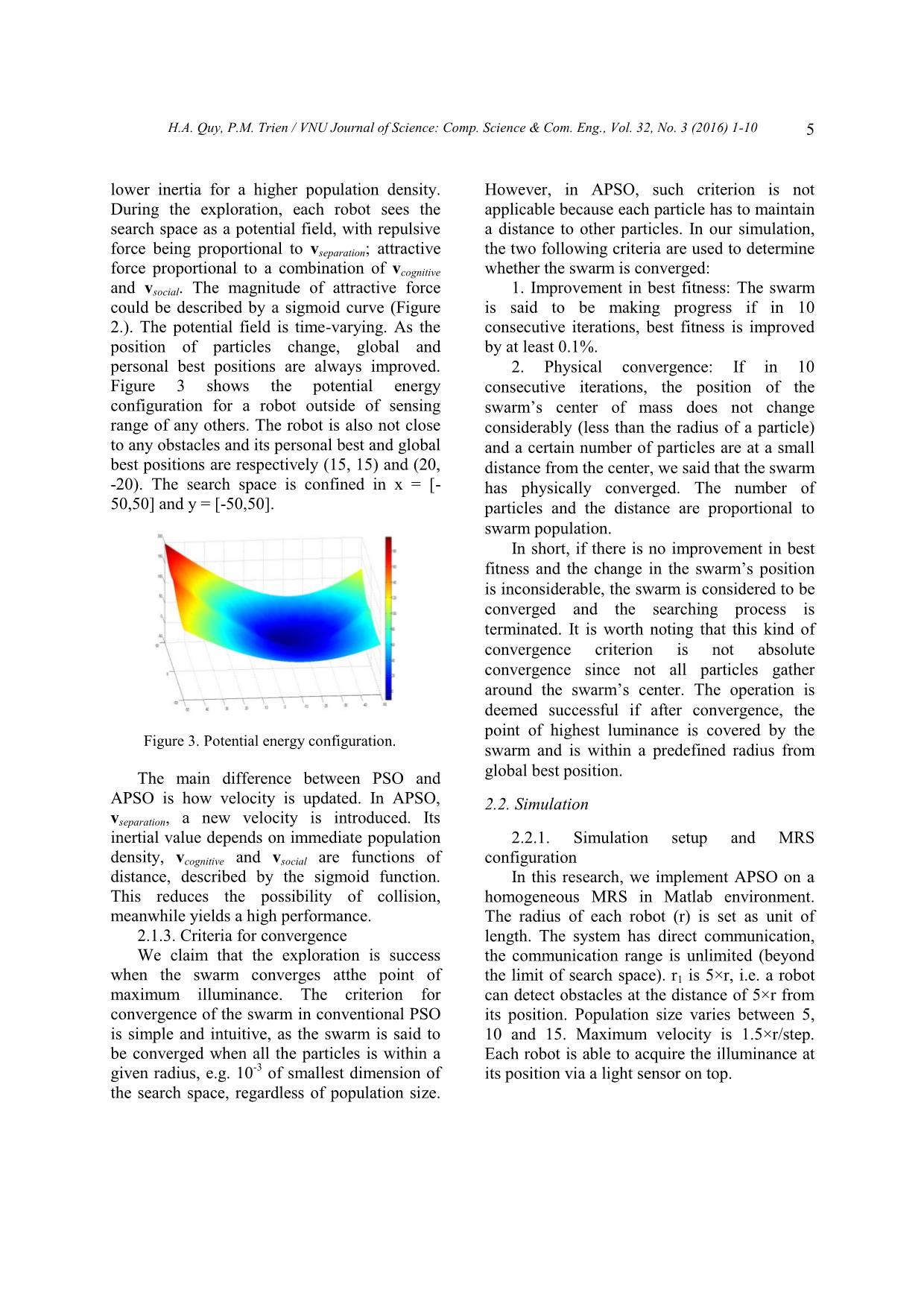
Trang 5
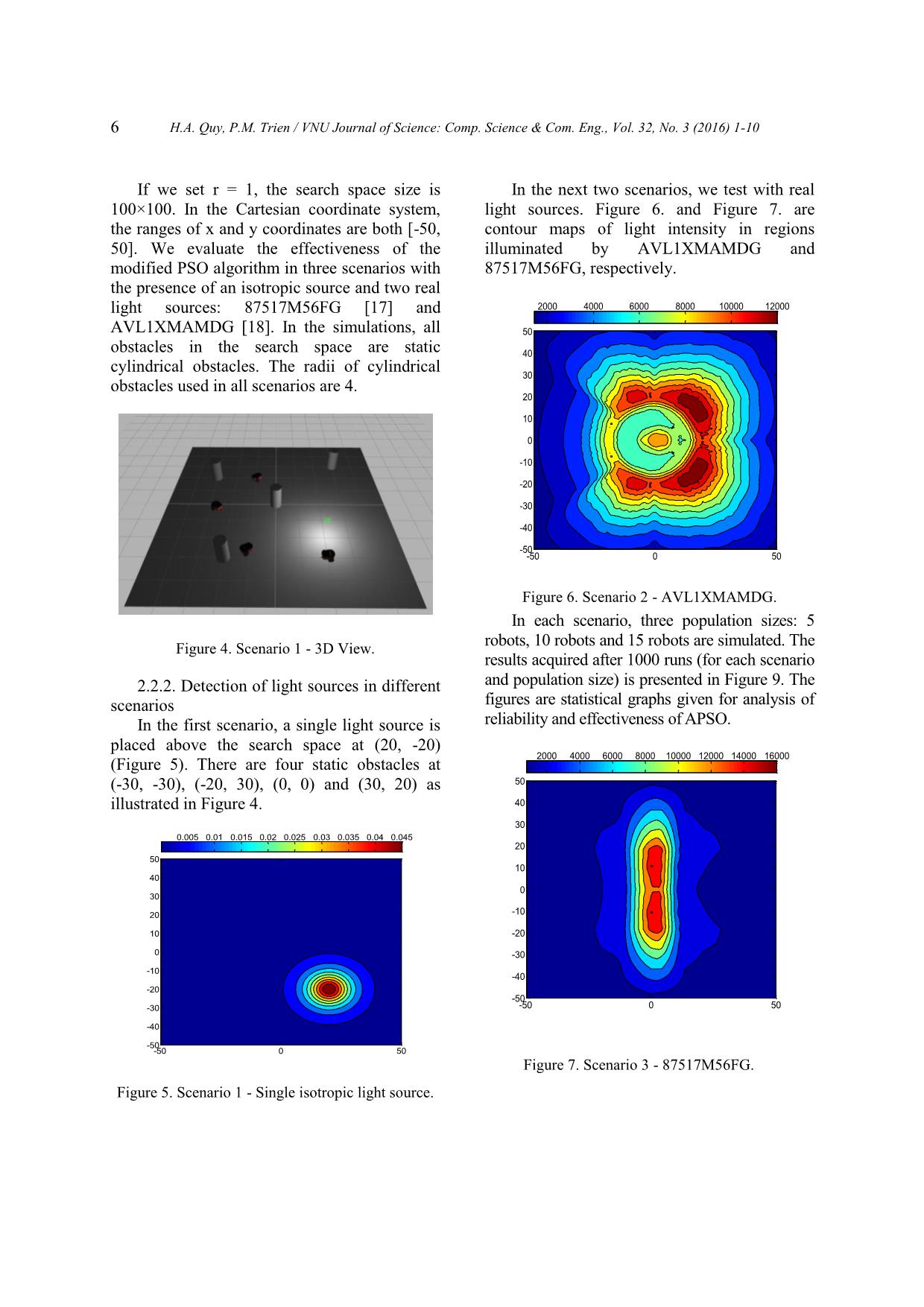
Trang 6
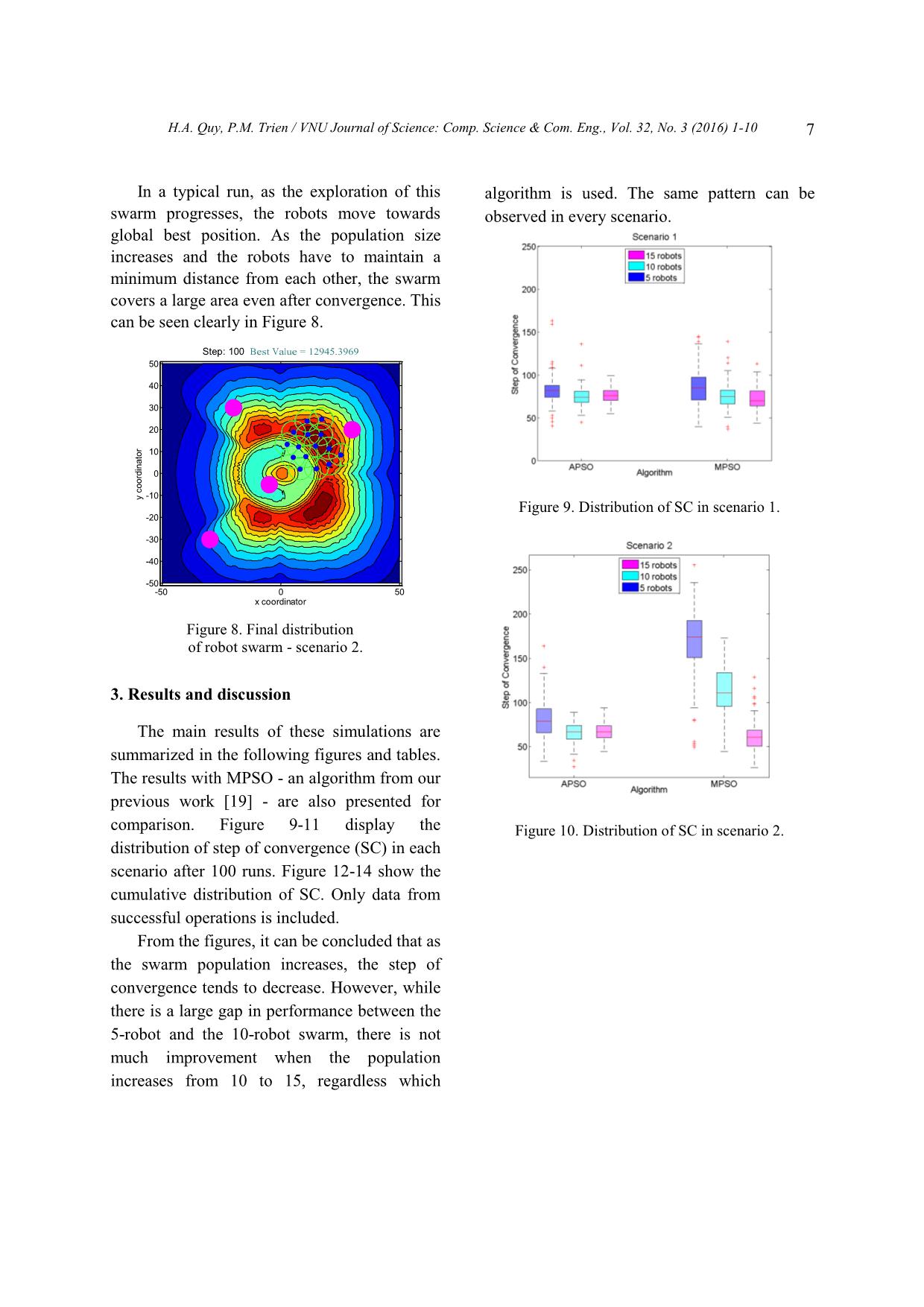
Trang 7
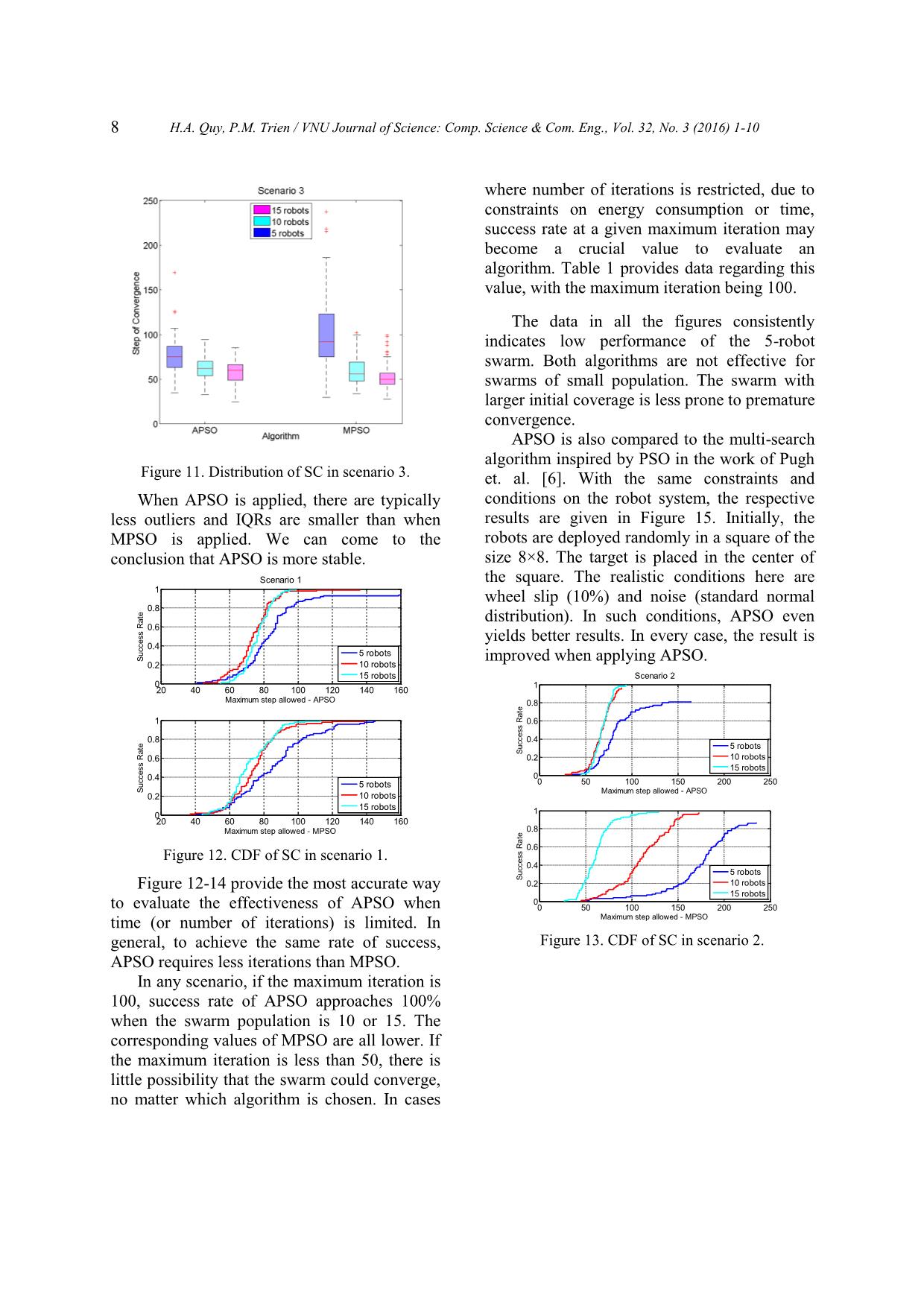
Trang 8
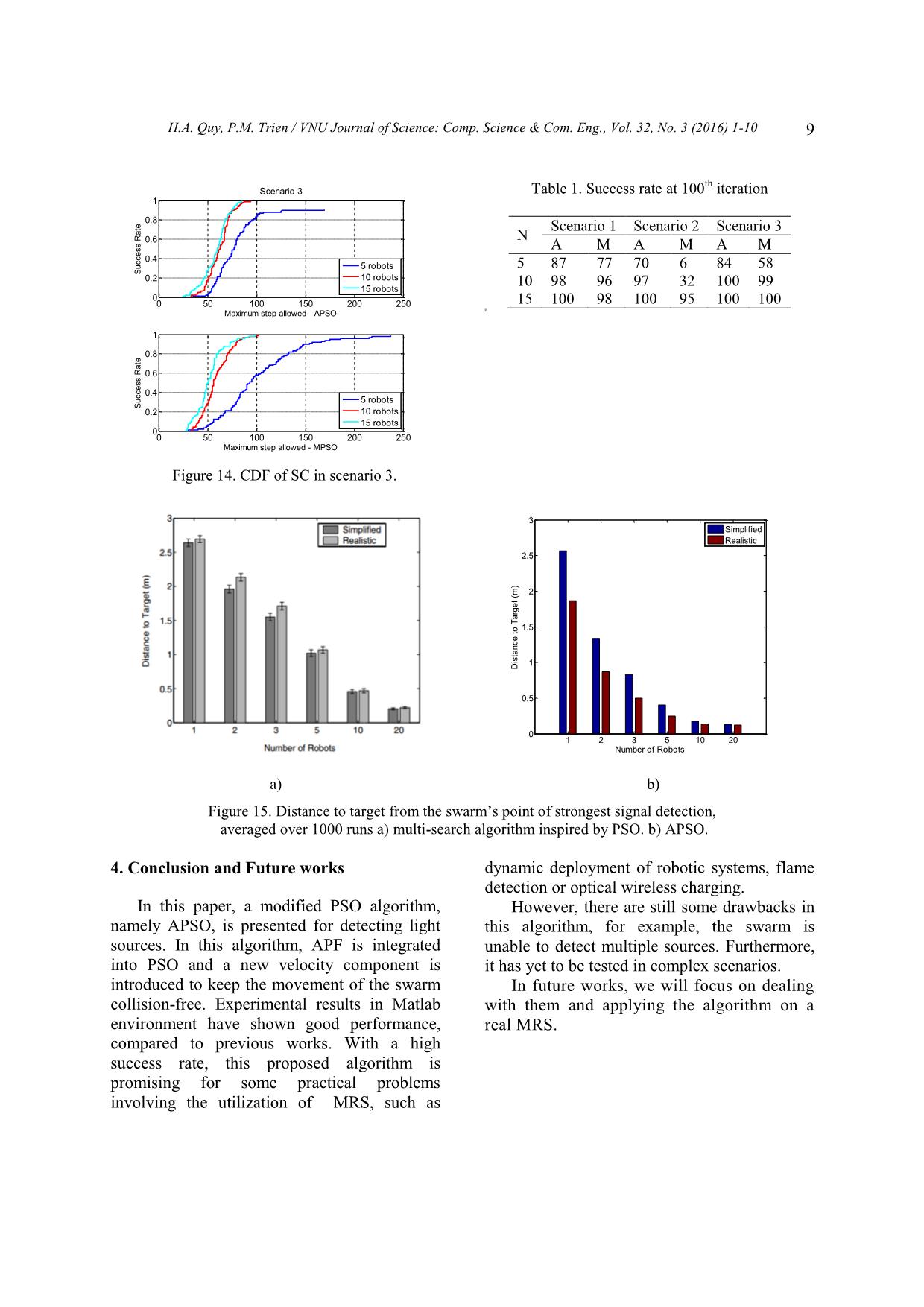
Trang 9
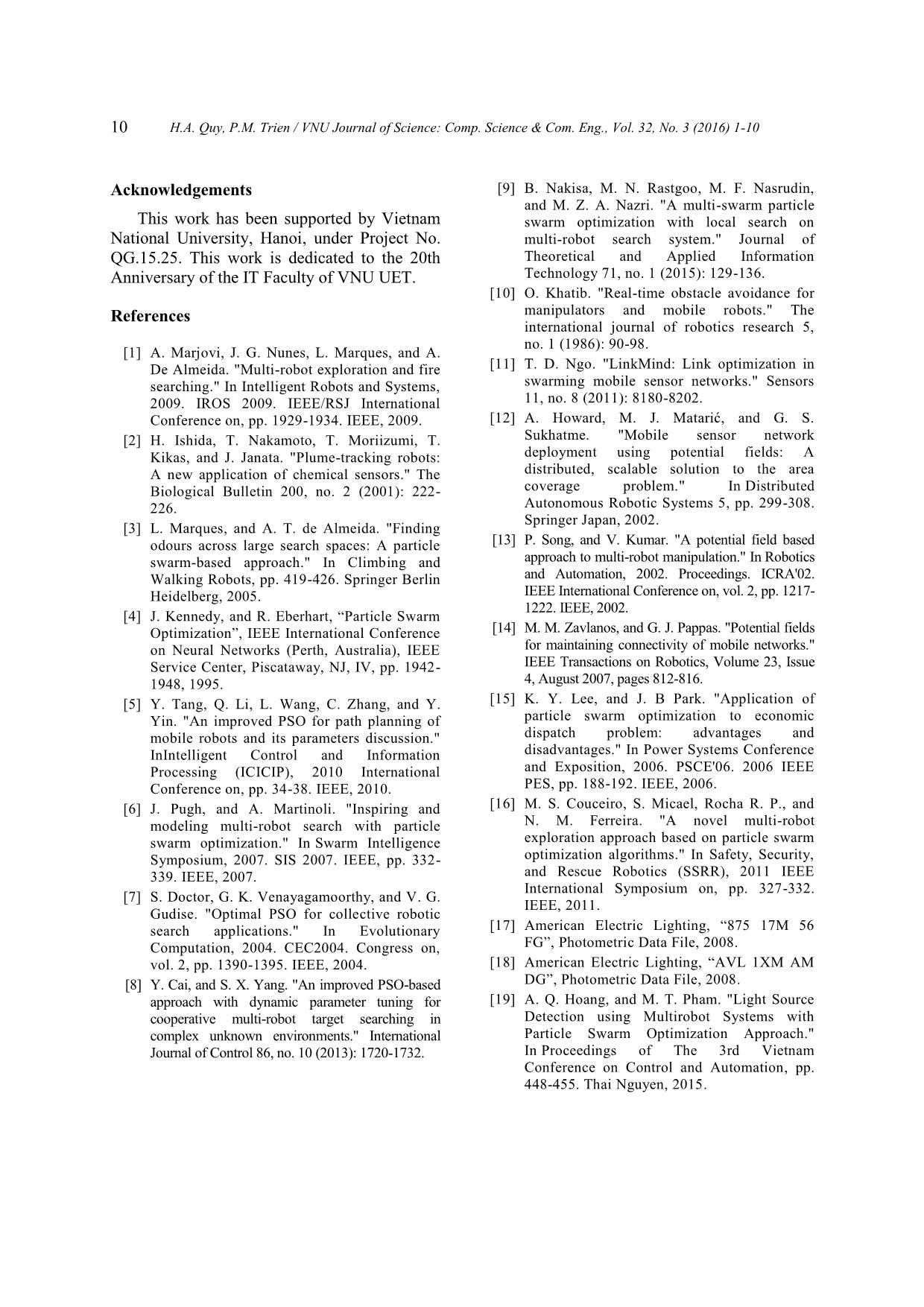
Trang 10
Tóm tắt nội dung tài liệu: Swarm optimization approach for light source detection by multi - Robot system
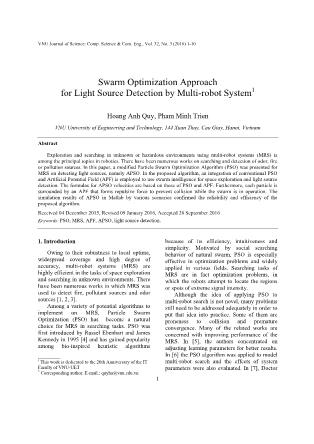
. Improvement in best fitness: The swarm could be described by a sigmoid curve (Figure is said to be making progress if in 10 2.). The potential field is time-varying. As the consecutive iterations, best fitness is improved position of particles change, global and by at least 0.1%. personal best positions are always improved. 2. Physical convergence: If in 10 Figure 3 shows the potential energy consecutive iterations, the position of the configuration for a robot outside of sensing swarm’s center of mass does not change range of any others. The robot is also not close considerably (less than the radius of a particle) to any obstacles and its personal best and global and a certain number of particles are at a small best positions are respectively (15, 15) and (20, distance from the center, we said that the swarm -20). The search space is confined in x = [- has physically converged. The number of 50,50] and y = [-50,50]. particles and the distance are proportional to swarm population. In short, if there is no improvement in best fitness and the change in the swarm’s position is inconsiderable, the swarm is considered to be converged and the searching process is terminated. It is worth noting that this kind of convergence criterion is not absolute convergence since not all particles gather around the swarm’s center. The operation is deemed successful if after convergence, the point of highest luminance is covered by the Figure 3. Potential energy configuration. swarm and is within a predefined radius from The main difference between PSO and global best position. APSO is how velocity is updated. In APSO, 2.2. Simulation vseparation, a new velocity is introduced. Its inertial value depends on immediate population 2.2.1. Simulation setup and MRS density, vcognitive and vsocial are functions of configuration distance, described by the sigmoid function. In this research, we implement APSO on a This reduces the possibility of collision, homogeneous MRS in Matlab environment. meanwhile yields a high performance. The radius of each robot (r) is set as unit of 2.1.3. Criteria for convergence length. The system has direct communication, We claim that the exploration is success the communication range is unlimited (beyond when the swarm converges atthe point of the limit of search space). r1 is 5×r, i.e. a robot maximum illuminance. The criterion for can detect obstacles at the distance of 5×r from convergence of the swarm in conventional PSO its position. Population size varies between 5, is simple and intuitive, as the swarm is said to 10 and 15. Maximum velocity is 1.5×r/step. be converged when all the particles is within a Each robot is able to acquire the illuminance at given radius, e.g. 10-3 of smallest dimension of its position via a light sensor on top. the search space, regardless of population size. 6 H.A. Quy, P.M. Trien / VNU Journal of Science: Comp. Science & Com. Eng., Vol. 32, No. 3 (2016) 1-10 If we set r = 1, the search space size is In the next two scenarios, we test with real 100×100. In the Cartesian coordinate system, light sources. Figure 6. and Figure 7. are the ranges of x and y coordinates are both [-50, contour maps of light intensity in regions 50]. We evaluate the effectiveness of the illuminated by AVL1XMAMDG and modified PSO algorithm in three scenarios with 87517M56FG, respectively. the presence of an isotropic source and two real light sources: 87517M56FG [17] and 2000 4000 6000 8000 10000 12000 AVL1XMAMDG [18]. In the simulations, all 50 obstacles in the search space are static 40 cylindrical obstacles. The radii of cylindrical 30 obstacles used in all scenarios are 4. 20 10 0 -10 -20 -30 -40 -50 -50 0 50 Figure 6. Scenario 2 - AVL1XMAMDG. In each scenario, three population sizes: 5 robots, 10 robots and 15 robots are simulated. The Figure 4. Scenario 1 - 3D View. results acquired after 1000 runs (for each scenario 2.2.2. Detection of light sources in different and population size) is presented in Figure 9. The scenarios figures are statistical graphs given for analysis of In the first scenario, a single light source is reliability and effectiveness of APSO. placed above the search space at (20, -20) 2000 4000 6000 8000 10000 12000 14000 16000 (Figure 5). There are four static obstacles at (-30, -30), (-20, 30), (0, 0) and (30, 20) as 50 illustrated in Figure 4. 40 30 0.005 0.01 0.015 0.02 0.025 0.03 0.035 0.04 0.045 20 50 10 40 0 30 20 -10 10 -20 0 -30 -10 -40 -20 -50 -30 -50 0 50 -40 -50 -50 0 50 Figure 7. Scenario 3 - 87517M56FG. Figure 5. Scenario 1 - Single isotropic light source. H.A. Quy, P.M. Trien / VNU Journal of Science: Comp. Science & Com. Eng., Vol. 32, No. 3 (2016) 1-10 7 In a typical run, as the exploration of this algorithm is used. The same pattern can be swarm progresses, the robots move towards observed in every scenario. global best position. As the population size increases and the robots have to maintain a minimum distance from each other, the swarm covers a large area even after convergence. This can be seen clearly in Figure 8. Step: 100 Best Value = 12945.3969 50 40 30 20 10 0 y coordinator y -10 Figure 9. Distribution of SC in scenario 1. -20 -30 -40 -50 -50 0 50 x coordinator Figure 8. Final distribution of robot swarm - scenario 2. 3. Results and discussion The main results of these simulations are summarized in the following figures and tables. The results with MPSO - an algorithm from our previous work [19] - are also presented for comparison. Figure 9-11 display the Figure 10. Distribution of SC in scenario 2. distribution of step of convergence (SC) in each scenario after 100 runs. Figure 12-14 show the cumulative distribution of SC. Only data from successful operations is included. From the figures, it can be concluded that as the swarm population increases, the step of convergence tends to decrease. However, while there is a large gap in performance between the 5-robot and the 10-robot swarm, there is not much improvement when the population increases from 10 to 15, regardless which 8 H.A. Quy, P.M. Trien / VNU Journal of Science: Comp. Science & Com. Eng., Vol. 32, No. 3 (2016) 1-10 where number of iterations is restricted, due to constraints on energy consumption or time, success rate at a given maximum iteration may become a crucial value to evaluate an algorithm. Table 1 provides data regarding this value, with the maximum iteration being 100. The data in all the figures consistently indicates low performance of the 5-robot swarm. Both algorithms are not effective for swarms of small population. The swarm with larger initial coverage is less prone to premature convergence. APSO is also compared to the multi-search algorithm inspired by PSO in the work of Pugh Figure 11. Distribution of SC in scenario 3. et. al. [6]. With the same constraints and When APSO is applied, there are typically conditions on the robot system, the respective less outliers and IQRs are smaller than when results are given in Figure 15. Initially, the MPSO is applied. We can come to the robots are deployed randomly in a square of the conclusion that APSO is more stable. size 8×8. The target is placed in the center of Scenario 1 the square. The realistic conditions here are 1 wheel slip (10%) and noise (standard normal 0.8 distribution). In such conditions, APSO even 0.6 yields better results. In every case, the result is 0.4 5 robots Success Rate Success improved when applying APSO. 0.2 10 robots 15 robots Scenario 2 0 1 20 40 60 80 100 120 140 160 Maximum step allowed - APSO 0.8 1 0.6 0.8 0.4 5 robots Success Rate Success 0.6 0.2 10 robots 15 robots 0.4 0 5 robots 0 50 100 150 200 250 Success Rate Success Maximum step allowed - APSO 0.2 10 robots 15 robots 1 0 20 40 60 80 100 120 140 160 Maximum step allowed - MPSO 0.8 0.6 Figure 12. CDF of SC in scenario 1. 0.4 5 robots Figure 12-14 provide the most accurate way Rate Success 0.2 10 robots 15 robots 0 to evaluate the effectiveness of APSO when 0 50 100 150 200 250 Maximum step allowed - MPSO time (or number of iterations) is limited. In general, to achieve the same rate of success, Figure 13. CDF of SC in scenario 2. APSO requires less iterations than MPSO. In any scenario, if the maximum iteration is 100, success rate of APSO approaches 100% when the swarm population is 10 or 15. The corresponding values of MPSO are all lower. If the maximum iteration is less than 50, there is little possibility that the swarm could converge, no matter which algorithm is chosen. In cases H.A. Quy, P.M. Trien / VNU Journal of Science: Comp. Science & Com. Eng., Vol. 32, No. 3 (2016) 1-10 9 th Scenario 3 Table 1. Success rate at 100 iteration 1 0.8 Scenario 1 Scenario 2 Scenario 3 N 0.6 A M A M A M 0.4 5 robots 5 87 77 70 6 84 58 Success Rate Success 0.2 10 robots 10 98 96 97 32 100 99 15 robots 0 0 50 100 150 200 250 15 100 98 100 95 100 100 Maximum step allowed - APSO D 1 0.8 0.6 0.4 5 robots Success Rate Success 0.2 10 robots 15 robots 0 0 50 100 150 200 250 Maximum step allowed - MPSO O Figure 14. CDF of SC in scenario 3. 3 Simplified Realistic 2.5 2 1.5 1 (m) Target to Distance 0.5 0 1 2 3 5 10 20 Number of Robots a) b) Figure 15. Distance to target from the swarm’s point of strongest signal detection, averaged over 1000 runs a) multi-search algorithm inspired by PSO. b) APSO. 4. Conclusion and Future works dynamic deployment of robotic systems, flame detection or optical wireless charging. In this paper, a modified PSO algorithm, However, there are still some drawbacks in namely APSO, is presented for detecting light this algorithm, for example, the swarm is sources. In this algorithm, APF is integrated unable to detect multiple sources. Furthermore, into PSO and a new velocity component is it has yet to be tested in complex scenarios. introduced to keep the movement of the swarm In future works, we will focus on dealing collision-free. Experimental results in Matlab with them and applying the algorithm on a environment have shown good performance, real MRS. compared to previous works. With a high success rate, this proposed algorithm is promising for some practical problems involving the utilization of MRS, such as 10 H.A. Quy, P.M. Trien / VNU Journal of Science: Comp. Science & Com. Eng., Vol. 32, No. 3 (2016) 1-10 Acknowledgements [9] B. Nakisa, M. N. Rastgoo, M. F. Nasrudin, and M. Z. A. Nazri. "A multi-swarm particle This work has been supported by Vietnam swarm optimization with local search on National University, Hanoi, under Project No. multi-robot search system." Journal of QG.15.25. This work is dedicated to the 20th Theoretical and Applied Information Anniversary of the IT Faculty of VNU UET. Technology 71, no. 1 (2015): 129-136. [10] O. Khatib. "Real-time obstacle avoidance for References manipulators and mobile robots." The international journal of robotics research 5, no. 1 (1986): 90-98. [1] A. Marjovi, J. G. Nunes, L. Marques, and A. De Almeida. "Multi-robot exploration and fire [11] T. D. Ngo. "LinkMind: Link optimization in searching." In Intelligent Robots and Systems, swarming mobile sensor networks." Sensors 2009. IROS 2009. IEEE/RSJ International 11, no. 8 (2011): 8180-8202. Conference on, pp. 1929-1934. IEEE, 2009. [12] A. Howard, M. J. Matarić, and G. S. [2] H. Ishida, T. Nakamoto, T. Moriizumi, T. Sukhatme. "Mobile sensor network Kikas, and J. Janata. "Plume-tracking robots: deployment using potential fields: A A new application of chemical sensors." The distributed, scalable solution to the area Biological Bulletin 200, no. 2 (2001): 222- coverage problem." In Distributed 226. Autonomous Robotic Systems 5, pp. 299-308. Springer Japan, 2002. [3] L. Marques, and A. T. de Almeida. "Finding odours across large search spaces: A particle [13] P. Song, and V. Kumar. "A potential field based swarm-based approach." In Climbing and approach to multi-robot manipulation." In Robotics Walking Robots, pp. 419-426. Springer Berlin and Automation, 2002. Proceedings. ICRA'02. Heidelberg, 2005. IEEE International Conference on, vol. 2, pp. 1217- 1222. IEEE, 2002. [4] J. Kennedy, and R. Eberhart, “Particle Swarm Optimization”, IEEE International Conference [14] M. M. Zavlanos, and G. J. Pappas. "Potential fields on Neural Networks (Perth, Australia), IEEE for maintaining connectivity of mobile networks." Service Center, Piscataway, NJ, IV, pp. 1942- IEEE Transactions on Robotics, Volume 23, Issue 1948, 1995. 4, August 2007, pages 812-816. [5] Y. Tang, Q. Li, L. Wang, C. Zhang, and Y. [15] K. Y. Lee, and J. B Park. "Application of Yin. "An improved PSO for path planning of particle swarm optimization to economic mobile robots and its parameters discussion." dispatch problem: advantages and InIntelligent Control and Information disadvantages." In Power Systems Conference Processing (ICICIP), 2010 International and Exposition, 2006. PSCE'06. 2006 IEEE Conference on, pp. 34-38. IEEE, 2010. PES, pp. 188-192. IEEE, 2006. [6] J. Pugh, and A. Martinoli. "Inspiring and [16] M. S. Couceiro, S. Micael, Rocha R. P., and modeling multi-robot search with particle N. M. Ferreira. "A novel multi-robot swarm optimization." In Swarm Intelligence exploration approach based on particle swarm Symposium, 2007. SIS 2007. IEEE, pp. 332- optimization algorithms." In Safety, Security, 339. IEEE, 2007. and Rescue Robotics (SSRR), 2011 IEEE International Symposium on, pp. 327-332. [7] S. Doctor, G. K. Venayagamoorthy, and V. G. IEEE, 2011. Gudise. "Optimal PSO for collective robotic search applications." In Evolutionary [17] American Electric Lighting, “875 17M 56 Computation, 2004. CEC2004. Congress on, FG”, Photometric Data File, 2008. vol. 2, pp. 1390-1395. IEEE, 2004. [18] American Electric Lighting, “AVL 1XM AM [8] Y. Cai, and S. X. Yang. "An improved PSO-based DG”, Photometric Data File, 2008. approach with dynamic parameter tuning for [19] A. Q. Hoang, and M. T. Pham. "Light Source cooperative multi-robot target searching in Detection using Multirobot Systems with complex unknown environments." International Particle Swarm Optimization Approach." Journal of Control 86, no. 10 (2013): 1720-1732. In Proceedings of The 3rd Vietnam Conference on Control and Automation, pp. 448-455. Thai Nguyen, 2015.
File đính kèm:
 swarm_optimization_approach_for_light_source_detection_by_mu.pdf
swarm_optimization_approach_for_light_source_detection_by_mu.pdf

